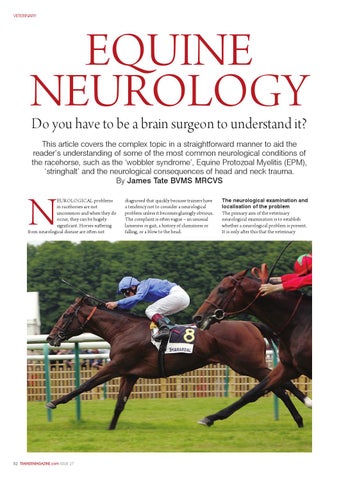NEUROLOGY ISSUE 27.qxd:Jerkins feature.qxd
21/8/09
13:26
Page 1
VETERINARY
EQUINE NEUROLOGY Do you have to be a brain surgeon to understand it?
This article covers the complex topic in a straightforward manner to aid the reader’s understanding of some of the most common neurological conditions of the racehorse, such as the ‘wobbler syndrome’, Equine Protozoal Myelitis (EPM), ‘stringhalt’ and the neurological consequences of head and neck trauma. By James Tate BVMS MRCVS
N
EUROLOGICAL problems in racehorses are not uncommon and when they do occur, they can be hugely significant. Horses suffering from neurological disease are often not
52 TRAINERMAGAZINE.com ISSUE 27
diagnosed that quickly because trainers have a tendency not to consider a neurological problem unless it becomes glaringly obvious. The complaint is often vague – an unusual lameness or gait, a history of clumsiness or falling, or a blow to the head.
The neurological examination and localisation of the problem The primary aim of the veterinary neurological examination is to establish whether a neurological problem is present. It is only after this that the veterinary
